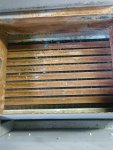This post was intended as continuation of "Rusting / Rot in Base of Raypak Heater" from June of 2018, but the blog system automatically created a new thread. See: Rusting / Rot in Base of RayPak Heater
I'm am working on a base rust problem on a RayPak Atmospheric R336. One thing I noticed is the base is made up of two pieces of sheet metal - an upper one and a lower stamping. Both can die due to clumsy accidents, like spilling a bottle of liquid chemical that runs under the heater and rusts from the outside in, or a partially blocked flue from the inside due to condensate formation.

Another problem I'm am sure you have is rusted flame spreaders. See attached. These are sheets of 16 gauge aluminized steel sheet metal that lay across the heat exchanger fins. When they rust they fall to pieces, blocking the free passage of exhaust gases and tend to cause condensate to drip into the firebox. Later the crumbling flame spreaders block the passage through the heat exchanger so much the flame starts to come out under the front and blow the flame-rollout fuse. In the photo attached I vacuumed up all the rust chips before I realized I should have taken a "before" photo. These flame spreaders were about $250 as replacement parts - I had a local sheet metal shop fabricate new ones from 20 gauge 304 stainless steel for under $60 and these new ones will never rust.
I'm am working on a base rust problem on a RayPak Atmospheric R336. One thing I noticed is the base is made up of two pieces of sheet metal - an upper one and a lower stamping. Both can die due to clumsy accidents, like spilling a bottle of liquid chemical that runs under the heater and rusts from the outside in, or a partially blocked flue from the inside due to condensate formation.

Another problem I'm am sure you have is rusted flame spreaders. See attached. These are sheets of 16 gauge aluminized steel sheet metal that lay across the heat exchanger fins. When they rust they fall to pieces, blocking the free passage of exhaust gases and tend to cause condensate to drip into the firebox. Later the crumbling flame spreaders block the passage through the heat exchanger so much the flame starts to come out under the front and blow the flame-rollout fuse. In the photo attached I vacuumed up all the rust chips before I realized I should have taken a "before" photo. These flame spreaders were about $250 as replacement parts - I had a local sheet metal shop fabricate new ones from 20 gauge 304 stainless steel for under $60 and these new ones will never rust.
Last edited:

